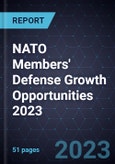Transformative Growth, Ramifications, and Implications from the Russo-Ukrainian War
As heavy clashes between Russian armed forces and the Ukraine military are generating continued stagnation on the battlefield, the Russo-Ukrainian war has come to a crossroad: though Ukrainian offensive efforts are currently challenged and the Russian side suffers heavy losses and lack of progress on ground armored maneuvers, the NATO alliance is sharpening its geo-strategy and military build-up plans, following the 2023 Alliance Summit.
In the light of the lessons being learned by observing the battlefield carefully, the NATO members’ defense markets are changing dramatically not only in terms of defense funding and budget allocations (with a mandatory expenditure of no less than 2% GDP for defense budget) but also in terms of creating a significant impact on end-user demands and requirements, heavy reliance on digitalization trends, software, and technology.
In addition, a military industrial base for mass production of arms, in Europe particularly, is about to emerge for the first time since the WW2; this will bring about a tremendous, historical shift in the European defense industry strategy and business models.
The repot overviews the evolving market business environment while discussing leading contracts, vendors, B2B, and G2G collaborations, and growth opportunities for the central pillars: main battle tank (MBT), missile defense (MD), unmanned aerial vehicles (UAV), and artificial intelligence (AI).
This analytics maps NATO members’ focus on military trends, flagship build-up programs and covers new concepts of operations (ConOps) and shifting demands based on geographic scope. The study also analyzes Russian military effectiveness on the battlefield and the lessons learned from the war which point at emerging business opportunities. Finally, the study discusses growth opportunities in various defense-relevant verticals and adjusted business models.








